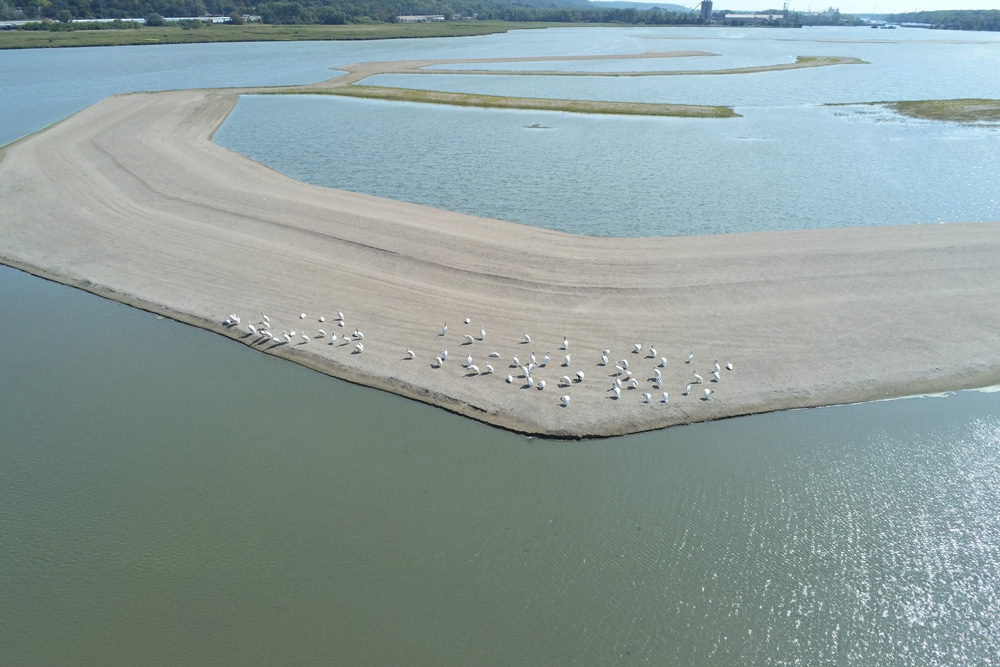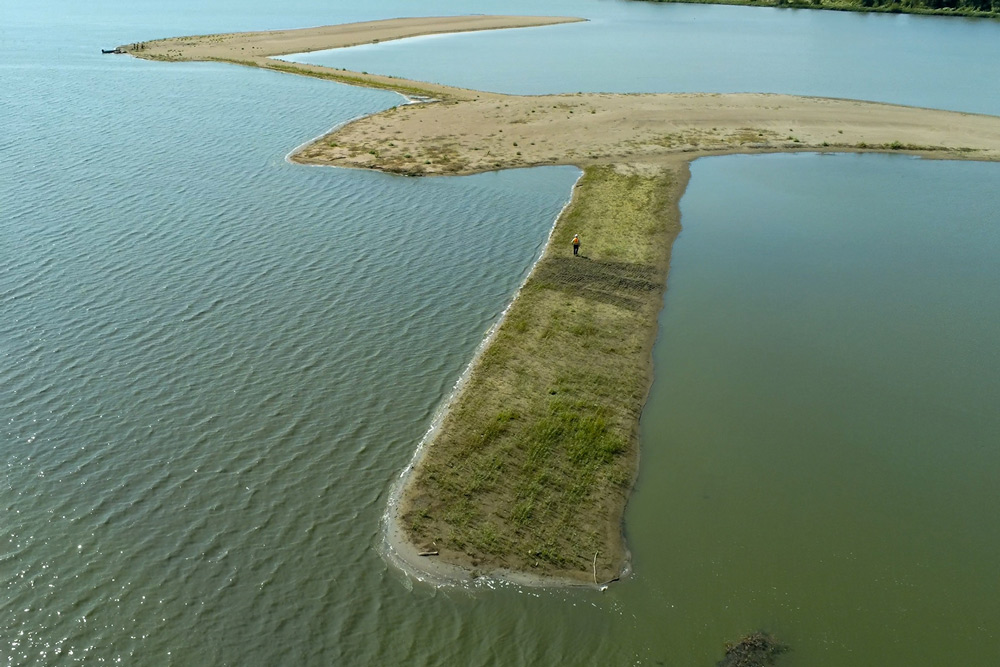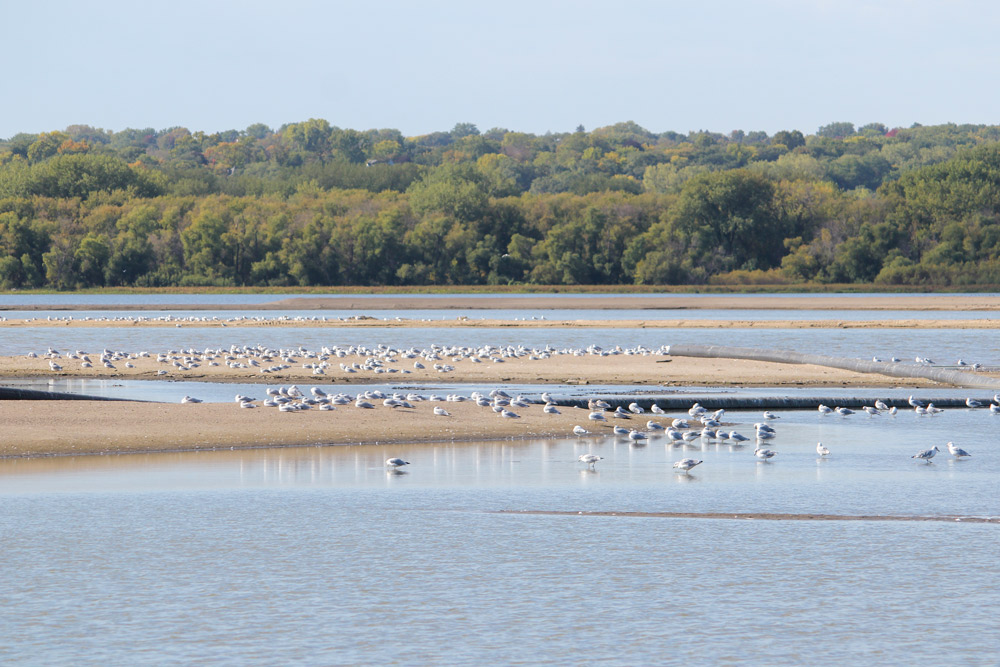Pigs Eye Lake Restoration Project

- Title: Pigs Eye Lake Restoration Project
- State: Minnesota
- Project type: USACE
- Greater Beneficial Use Area: Upper Mississippi River
- Focus Area approximate center coordinates: 44.91601, -93.0290
- Nearest Federal Navigation Project: Upper Mississippi River Pool 2
- Owner: USACE St. Paul District
- Beneficial Use Categories: Beach/Shoreline Nourishment, Island Habitats, Wetland Habitats
- Dredge type: Hydraulic
- Status: Ongoing
- Keywords: island creation, hydraulic placement, restoration, habitat, erosion control
Description:
Pigs Eye Lake, a 628-acre shallow backwater lake located southwest of St. Paul, Minnesota, forms part of the Pool 2 area of the Upper Mississippi River (UMR). Formed following the construction of a series of locks and dams in 1930 to facilitate UMR channel navigation, Pigs Eye Lake, is not only a crucial habitat for one of Minnesota’s largest nesting colonies of waterbirds, including herons, egrets, and cormorants, but also a regarded oasis within its urban surroundings, enriching the quality of life for local residents. However, the lake has faced multiple challenges, including shoreline erosion, deteriorating water quality, and a loss of aquatic vegetation and habitat diversity.
In 2012, Ramsey County requested that the US Army Corps of Engineers (USACE) – St. Paul District (MVP) beneficially used sediment dredged from the UMR navigation channel for the restoration of Pigs Eye Lake. This approach was particularly advantageous for MVP, given the limited number of sediment placement sites in Pool 2 for routine maintenance dredging. The project aimed to use dredged sediment to build islands in the lake, enhancing both aquatic and terrestrial habitats for fish and migratory birds. This included improving vegetation and creating thermal shelters for waterfowl while also protecting the lake’s shoreline from erosion and reducing turbidity caused by wind and wave action.
The restoration of Pigs Eye Lake faced several challenges, such as operating equipment in shallow water, protecting wildlife in the project area, and concerns about disturbing contaminated sediments. The project team addressed these challenges through extensive outreach, coordination, and compliance with regulatory standards, alongside innovative sediment placement methods to minimize bottom disturbance. The project, with a budget of $14.7 million, was funded through the USACE civil works program, Ramsey County's Conservation Partners Legacy Grant Program, and the Lessard-Sams Outdoor Heritage Council.
In fall 2023, approximately 448,000 cubic yards of dredged sand was hydraulically placed into the lake to serve as a foundation for six new islands. The sand was primarily sourced from the Pine Bend Island stockpile, containing sediment dredged from the UMR. The islands were then terraced to accommodate different native plant species. After establishing the island bases, the project team added a layer of topsoil and native plantings and incorporated rocks to protect against erosive wave action. Native vegetation, including willows (Salix spp.), is scheduled for planting in spring 2024.
The Pigs Eye Lake restoration project has successfully created 40 acres of island habitat, featuring sand benches, terrestrial plantings, and protected marshes. Early ecological assessments indicate that waterfowl, herons, and seagulls are already using the islands, and new plantings are flourishing. All progress reports indicate a positive trajectory toward restoring the ecological balance of Pigs Eye Lake. Effective stakeholder communication was integral to the project’s success. The project successfully addressed sediment disposal constraints, community concerns, and erosion control, all while maintaining critical navigation infrastructure. This initiative not only promises to enhance the ecological resilience of Pigs Eye Lake but also serves as a model for future ecosystem restoration projects along the Mississippi River.
Gallery:
Further readings:
- Miller J. (2023). Trip Report for Pig’s Eye Lake Island Construction Beneficial Use Project. USACE. August 14. PDF
- USACE St. Paul District. (2020). Pool 2 Dredged Material Management Plan: Upper Mississippi River, Hennepin, Ramsey, Dakota and Washington Counties, Minnesota. March.
- USACE St. Paul District. (2023). Pigs Eye Lake Restoration Project.
Website links:
- Ramsey County. (2018). Pigs Eye Lake Island Building Project.
Videos:
Island Building and Habitat Restoration: Utilizing Dredged Material for Environmental Benefits. YouTube, Uploaded by J.F. Brennan Company, 17 August 2023.
Pigs Eye Islands Environmental Restoration Project. YouTube, Uploaded by MVP Public Affairs, 20 September 2023.
News releases:
- Marohn K. (2022). Project underway to build islands in Pig’s Eye Lake in St. Paul. Minnesota Public Radio News. June 12.
- Ramsey County. (2022). Island Construction in Pigs Eye Lake Begins. June 7.
- Thompson N. (2022). New Islands in St. Paul’s Pigs Eye Lake Draw Both Support and Scrutiny. Twin Cities Pioneer Press. August 22.
- USACE St. Paul District. (2018). Corps Seeks Comments on Habitat Restoration Project on Pigs Eye Lake. March 12.
- USACE St. Paul District. (2022). Corps of Engineers Set to Begin Island Construction in Pigs Eye Lake. June 7.




